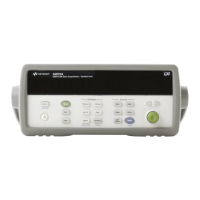Theory of Operation 5
Keysight 34970A/34972A Service Guide 167
The 74HC240’s, U205 and U206, provide the output high drive current necessary
to maintain a TTL high output level (= 2.4 VDC) under load.
At instrument turn-on, following a reset, and whenever the data lines are being
read, the MOSFETs are in the passive high state, and the high output drivers are
disabled. The resistor connected between the MOSFET’s gate and ZGND holds
the gate near ground potential when the module is initially turned-on to ensure
that the MOSFET is in the passive high state.
The comparators U301, U302, U401 and U402 maintain correct TTL high and low
levels by shifting the voltages from the input to compensate for the forward
voltage drop of the blocking diode. A reference voltage of +2.1 VDC (TTL_REF) is
applied to the inverting input of the comparator. When the input voltage is in the
range of 0 VDC to +4.3 VDC the blocking diode is forward biased and its forward
voltage drop is added to the applied voltage. For example, when 0 VDC is applied
to the data line, +0.7 VDC is present on the non-inverting input of the comparator
and the comparator output is low. When the input signal level is above 1.4 VDC, a
voltage greater then +2.1 VDC is applied to the non-inverting input of the
comparator causing its output to go high. When the input signal is less than 1.4
VDC, a voltage less than 2.1 VDC is applied to the comparator’s non-inverting
input causing its output to go low. This ensures an input voltage < 1.4 VDC is
interpreted as a TTL low level and an input > 1.4 VDC is interpreted as a TTL high
level.
The pull-up resistor (connected to the comparator’s non-inverting input) allows
external ground connections and open circuits to be detected. When the data line
is grounded, the blocking diode is forward biased applying a +0.7 VDC level to the
comparator, a TTL low. When the data line is allowed to float, the non-inverting
input of the comparator pulls up to +5 VDC, a TTL high.
The blocking diode on the output is used for circuit protection. The diode reverse
biases when the applied voltage exceeds +4.3 VDC preventing externally supplied
current from being injected into the module’s +5V supply line.
The MOSFETs have a built in zener diode that conducts at any voltage of
approximately 75 VDC or greater. The zener diode provides protection from
external over voltage situations including static electricity.

